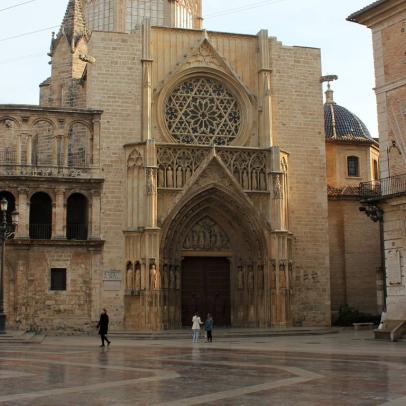Construction on the cathedral, whose predominant architectural style is Gothic, started on the 13th century. The cathedral has undergone several alterations over the centuries, though it still has many medieval signs. Valencia Cathedral was built on the site of the Great Mosque, which in turn had been raised during the Islamic period in place of the former Visigothic cathedral.
In the year 1096, Rodrigo, who had already established himself as lord of Valencia, converted the mosque into a Christian cathedral. The document ordering this conversion, which contains El Cid’s ("Ruderico") signature, is kept at Salamanca Cathedral, where it was taken when Valencia fell to the Almoravids (1102).
It is one of the most outstanding and remarkable cathedrals in Spain, especially because of the belltower to the left, which is known as Miguelete or Micalet. The building is Gothic in style, though other styles are visible. For example, the cathedral’s apse is from the Roman-Visigoth period and the Puerta del Palau or Almoina has an impressive late Romanesque façade. These styles mix with other architectural styles (Renaissance, Baroque and Neoclassical).
The cathedral is shaped in the form of a Latin Cross and has an ambulatory and a large base of dome over the transept. These elements are in sharp contrast to the names, which are smaller in size. The most outstanding Gothic parts are as follows: Puerta de los Apóstoles (1300), the chapel of the Holy Grail (1356), the belltower Micalet (1381) and the chapel of San Jordi.
The Chapel of the Holy Grail inside Valencia Cathedral houses one of the most famous saintly relics of the Christian culture in the western world: the Holy Chalice or Holy Grail, the very cup used by Jesus Christ during the Last Supper.
Visits: Admission tickets. Check opening hours and prices at the cathedral of Valencia.
Rev. PAB 27.12.18










